
|
Sale 38
Manuscript and Collectibles Auction
| Lot |
Photo |
Description |
Realized |
Lot 1176 |
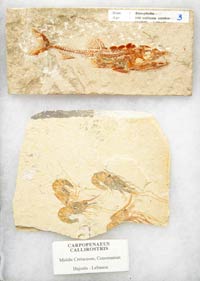 |
100 Million Year Old Viper Fish And Shrimp From Lebanon. Some of the most beautifully-preserved fossils are found in the 100 million year old fossil beds of Hajoula, Lebanon. The first of the two slabs is a complete 4 �" long Viper Fish Europholis. Its orange-brown color is nicely contrasted by the lighter cream-colored matrix and the small intricate details are present including some of its small sharp teeth and interesting ventral circular protective plates. The second 5" x 4" plate contains three complete and one partial shrimp, Carponenaeus. The detail on these brown shrimp is amazing with their translucent shell, delicate legs and antennae and red eyes. Both fossil plates are contained in a 12" x 8" Ryker mount. Add $20.
Estimated Value $300 - 400.
View details and enlarged photo
| Unsold |
Lot 1177 |
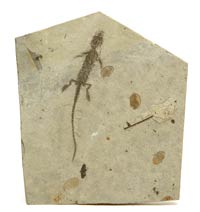 |
110 Million Year Old Salamander From Liaoning, China. This excellent 4" salamander, Liaoxitriton zhongjiani was found in a site near Huludao City of western Liaoning, China. This site represents the youngest upper level fossil zone in Liaoning. The 5 ½" x 5" gray volcanic tuffaceous stone matrix also contains four small shells from a bivalve crustacean, Eosetheria, which is a clam shrimp, as well as a 1" long stem from a water plant. The main salamander has an excellent skull with teeth and body. Some parts of the back feet and end of the tail have been enhanced to make them complete. Displayed in an 8" x 8" Chinese box. Add $20 for domestic shipping.
Estimated Value $300 - 400.
View details and enlarged photo
| Realized
$437 |
Lot 1178 |
 |
125 Million Year Old Aquatic Reptile. Sinohydrosaurus lingyuanensis was an unusual swimming reptile with a very long neck and tail. It lived 125 million years ago in the fresh water lakes in Liaoning Province of northeastern China. The very small delicate bones of this 4" long baby were preserved only because the tiny reptile was buried in a massive volcanic eruption more than 125 million years ago. The museum quality of this fossil was so exceptional that it was mounted in a 10½x10½" frame to either hang or to stand upright on a desk. Every bone, with the exception of just a few of the tail bones near the end, is preserved in excellent detail. Even the tiny feet and claws are complete along with very fine, thin rib bones. The light brown bones are nicely contrasted on the pale gray 5½x5" stone matrix, which has been placed on a blue background inside the dark brown frame. Add $20 for domestic shipping.
Estimated Value $400 - 600.
View details and enlarged photo
| Realized
$270 |
Lot 1179 |
 |
14" Long Juvenile Mammoth Tusk. This 14" long wooly mammoth tusk is nearly complete with just a 4" section having been chipped off of one side. Complete Mammuthis primigenius tusks are quite rare and small juvenile tusks are much rarer still. The delicate tips of these small tusks are usually missing. This splendid little tusk has its full tip and it has had its ivory polished, revealing several different shades of brown. These colors resulted from the original white ivory being mineralized over thousands of years with minerals such as vivianite and iron phosphate. This rare little tusk was found in the Taymyr Peninsula of Siberian. it is between 30,000 and 100,000 years old. Add $20 for domestic shipping.
Estimated Value $500 - 750.
View details and enlarged photo
| Unsold |
Lot 1180 |
 |
14" Long Triceratops Brow Horn. Triceratops is one of the most famous and recognizable dinosaurs, with its two long sharp brow horns that it used for defense against the T-Rex, as well as fighting for mates. No complete skeleton has ever been found, but occasional skulls and horns are found in Montana. Such is the case here with a virtually complete supraorbital horn (brow horn) of a juvenile Triceratops, with some surface weathering of the bone core. The 14x4" horn has some wear on the tip and, as always, there are some cracks that have been professionally filled and perfectly blended in color and texture to the dark brown bone. The horn is straight and not distorted like most offered. When the triceratops was alive, the horn bone was covered in keratin--the same substance that makes up our fingernails--and would have been 30% larger than it now is. This is a rare dinosaur horn of one of the last dinosaurs that lived from 67-65 million years ago in eastern Montana. Add $45 for domestic shipping.
Estimated Value $1,300 - 1,600.
View details and enlarged photo
| Unsold |
Lot 1181 |
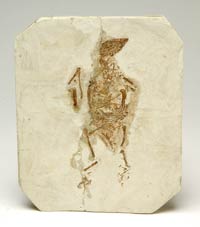 |
140 Million Year Old Bird Fossil From China. Some of the oldest bird fossils ever found come from Liaoning Province of northeastern China. This small, 5¼" primitive bird, Liaoxiornis delicatus, was alive in the late Jurassic period, 140-135 million years ago. Only Archaeopteryx from Germany is older at 150 million years old. Birds have light delicate bones that are rarely preserved and this nearly complete bird is remarkable in the details of its preservation. Due to an enormous volcanic eruption 140 million years ago, this bird was killed by the poisonous gases and quickly buried in the volcanic ash that slowly hardened over millions of years to form the very soft stone matrix that still surrounds the delicate bones.
The fossil is a dark brown color against a crème tuffaceous stone matrix. This remarkable specimen is complete except for the two hands and a couple of claws on the foot bones, which are present but slightly disarticulated. The skull is excellent with even a couple of its very small teeth visible near the tip of the beak. There are even traces of the feathers around the head, one of the wings, and at the end of the body. The outline of the feathers is visible as a light, carbonized impression running the length of the body. This important fossil bird is nicely centered on a 7x5" stone matrix, which has been repaired down the middle but does not affect the bird. All fossil Chinese birds are in great demand as there will not be any more coming out of China. Add $20 for domestic shipping.
Estimated Value $1,400 - 1,800.
View details and enlarged photo
| Realized
$1,553 |
Lot 1182 |
 |
18 Million Year Old Hop-toad. Frogs and toads are quite rare in the fossil record because of their delicate bones. One of the rare exceptions is the 18 million year old fossil frogs and toads from Shanwang Village, a small village in the Shandong Province of China. These delicate fossils are preserved in the fine grained and fragile diatomaceous shale. This shale crumbles so easily that it must be held together with a special wax. This lovely light and dark brown 5 ½" hop-toad is nearly complete with its large head, body and all legs with the slender digits of the feet missing only a couple of the toes. The Hoptoad is nicely centered on a 6" x 4 ½" matrix and protected in a 8" x 6" Ryker mount. Add $15 for domestic shipping.
Estimated Value $400 - 600.
View details and enlarged photo
| Realized
$374 |
Lot 1183 |
 |
22x9" Slab of Floating Scyphocrinites Crinoid Crowns. Found in Erfoud, Morocco, this large, rust-brown slab is an amazing example of the Crinoids with very fine detail. Measuring around 3x3", each of the five bulb heads (crowns) still have attached partial stems in exquisite detail. Looking closely at each, it is possible to see the animal's feather-like feeding arms and small, star-shaped calcite plates at the crown's base, attached to the stem. Crinoids are related to star fish and are known as "sea lillies" because they resemble plants more than the animals that they are. The Scyphocrinites were an interesting floating Crinoid with its stem attached to a round, air-filled bulbthat floated on the surface of the ocean. The upside-down Crinoid filter fed small organisms, like plankton, that lived near the surface of the ocean. This was highly unusual as most Crinoids were attached to the ocean bottom. When these Crinoids died, they would separate from their floatation bulbs and settle on the bottom. Add $35 for domestic shipping.
Estimated Value $500 - 750.
View details and enlarged photo
| Unsold |
Lot 1184 |
 |
70 Million Year Old Duckbill Dinosaur Egg. This complete unhatched Hadrosaur (Duckbill) dinosaur egg is 70-80 million years old, 6" long and 5" wide and is museum quality with nearly 100% of its original shell still intact. It was found by farmers from the Xixia, Henan Province of China. The exact species of dinosaur cannot be determined from just the egg, but this shape of egg has been determined to be from a duckbilled dinosaur from duckbilled dino bones found in the area of these recovered eggs. Bones from the huge Hadrosaur Shantungosaurus, which reached more than 50 feet in length, have been found in the same area. Fewer than 1% of dinosaur eggs are as complete and pristine as this egg, which is still positioned on a small red sandstone base of the original stone matrix. Add $25 for domestic shipping.
Estimated Value $500 - 750.
View details and enlarged photo
| Realized
$489 |
Lot 1185 |
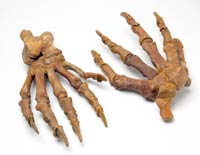 |
Cave Bear Hand & Foot With Sharp Claws. Ursus spelaeus, the Cave Bear, was the largest bear that ever lived, standing over ten feet tall, and has only been extinct for 10,000 years. These complete hand and feet bones are solid and light brown in color, and were found in the Bihor mountains of Romania, where they lived between 25,000-35,000 years ago. Both are extremely large, with the hand being 11" long and 6" wide and the foot 11½" long and 5" wide. Both have sharp claws up to 1½" long, which gives us some idea of the ferocity of these huge bears. Add $25 for domestic shipping.
Estimated Value $400 - 600.
View details and enlarged photo
| Realized
$575 |
Lot 1186 |
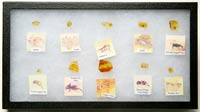 |
Collection of 10 Nuggets Of Baltic Amber. Baltic amber is 35-40 million years old and is mined around the southern coast of the Baltic sea. Most Baltic amber has Succinic acid in it, which probably originated in an extinct pine tree named Pinites succiniter. Baltic amber is highly prized for its color and clarity. The ten amber nuggets in this premium collection consists of two scarce spiders, a moth fly, a moth with excellent wing detail, two pieces with long-legged flies, one of which contains four flies, a scuttle fly and mite, a fungus gnat, a biting midge and true midge and a worker ant. Each of these amber nuggets has a 1½x1¼" enlarged photo of the insect inclusion and the entire group is housed in a 14x8" Ryker mount. Add $20 for domestic shipping.
Estimated Value $300 - 400.
View details and enlarged photo
| Realized
$345 |
Lot 1187 |
 |
Collection Of 6 Theropod Dinosaur Teeth From Morocco. Carcharodontosaurus saharicus was the T-Rex of the Sahara in Morocco 80-90 million years ago. It was even bigger than a T-Rex and the top predator of that time. Its dagger-like teeth with sharp serrations like a steak knife give evidence of it ferocious nature. All six of these well-matched, light-brown teeth were found in a single location in the Kem Kem Valley area near Taouz, Morocco. These six shed teeth range in size from just over 1" to over 2½" long. They all possess good enamel and serrations with just the usual minor chipping and a few cracks. They could be from a single dinosaur or several as theropod dinosaurs shed their teeth often when feeding and then the teeth grew back so that a single dinosaur might have teeth that were 1" long and others that were 4" in length. The change in shape of the teeth can be analyzed from the 1" to the much thicker and fatter 2½" tooth. There can be great variability in the teeth from dinosaur to dinosaur and also their placement in the jaw. This interesting collection is housed in a 12x8" Ryker mount. Add $20 for domestic shipping.
Estimated Value $300 - 500.
View details and enlarged photo
| Realized
$345 |
Lot 1188 |
 |
Collection of 8 Amber Nuggets With Rare Insect Inclusions. Dominican amber is 25-40 million years old, originating from the resin of the now-extinct Hymenaea tree that grew in an ancient rain forest. The amber is mined from the remote mountains from the La Cumbre region. This collection of eight amber nuggets was put together to represent the rarer fossils found in Dominican amber, including a Pseudoscorpion, a spider with a tiny midge clinging to its leg, a Gall Midge with eight eggs, an unusual seed wasp and beetle, eggs found inside a piece of amber that is inside a large piece, a Fungus Gnat with two eggs, a black Scavenger Fly and a Worker Ant. These amber nuggets are clear and vary in size from ½" to 1" and each has an enlarged 1¼x1¼" color photograph of the valuable insect inclusion. Housed in an 8½x6½" Ryker mount for protection and display. Add $20 for domestic shipping.
Estimated Value $400 - 600.
View details and enlarged photo
| Realized
$575 |
Lot 1189 |
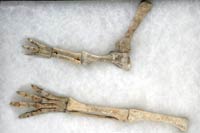 |
Complete Arm and Leg of a Psittacosaurus Dinosaur. This large 15½" long leg, complete down to the claws, and 14½" long arm and hand belong to Psittacosaurus, the earliest ancestor of all the famous horned dinosaurs. Psittacosaurus was a small dinosaur of only 4-5 feet in length when fully grown. This impressive arm and leg belong to a fully grown adult. The large foot measures 5" long with claws over 1" in length. All of the bones in the foot have been professionally attached in the correct position and can be easily examined. The hand is 2½" long down to the claws, which are up to ½" long. In life the claws would have been covered in keratin, the same substance that forms our fingernails. Found near Beipiao City in Liaoning Province of northern China, this 125-130 million year old dinosaur is more than 60 million years older than its more famous relative, Triceratops. Add $50 for domestic shipping.
Estimated Value $600 - 800.
View details and enlarged photo
| Unsold |
Lot 1190 |
 |
Complete Curved Mammoth Tusk. Complete tusks from a wooly mammoth, Mammuthis primigenius are rare. This complete 38" long tusk is a beautiful dark brown color with several different shades of brown blending to give it a very striking appearance. The fossil ivory has been polished to preserve it, plus add to its beauty. These colors resulted from the original white ivory being mineralized over thousand of years with minerals such as vivianite and iron phosphate. This museum-quality tusk was found in the Taymyr Peninsula of Siberia and is between 30,000 and 100,000 years old. Most Mammoth tusks recovered are broken and only partials. Obtaining a complete tusk is a real buying opportunity. Add $85 for domestic shipping.
Estimated Value $1,800 - 2,200.
View details and enlarged photo
| Unsold |
Lot 1191 |
 |
Complete Duckbill Dinosaur Toe. This 10 ½" long, fourth digit Edmontosaurus annectans toe is complete with just minor cracks and a few chips as found. From the 65-67 million year old Hell Creek Formation of Montana, Edmontosaurus was a large 40 foot long hadrosaur dinosaur that lived at the same time and place as Tyrannosaurus Rex and was undoubtedly one of its favorite prey. Duck-bill dinosaurs had webbed feet and this can be seen from the wide 3 ¼" x 3" hoof bone where the webbed skin attached to its base. This rare dinosaur toe is complete with its hoof and four phalanges. Add $25 for domestic shipping.
Estimated Value $700 - 900.
View details and enlarged photo
| Unsold |
Lot 1192 |
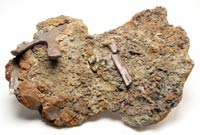 |
Dinosaur Feeding-Frenzy Slab. This unusual, large 20" x 14" slab of fossil teeth and bones is exactly as it was recovered from the late cretaceous Hell Creek Formation of South Dakota. Normally these valuable fossils are just removed from the 65-70 million year old rock matrix and then cleaned and sold. In this rare grouping, all of the fossils have been left in place for study. There are several large pieces of bone from a Triceratops, including a 10" long, 4 ½" wide rib bone and another rib bone 6" long. There are two shed teeth from either a Nanotyrannus or a juvenile T-Rex; one is 1 12" long and the other is 1" only. A Nanotyrannus looked much like a miniature T-Rex and its teeth are virtually the same as those from a young T-Rex. Therefore, we can�t say for certain which dinosaur was responsible for feeding on the Triceratops, but shed teeth are commonly found with the bones of the prey dinosaur, as they would break off when the T-Rex was chomping on solid bones. The existence of a 1" long tooth from a Champosaur, which was something like a running crocodile, shows that more than one animal fed on the Triceratops. Add $75 for domestic shipping.
Estimated Value $1,000 - 1,250.
View details and enlarged photo
| Realized
$1,093 |
Lot 1193 |
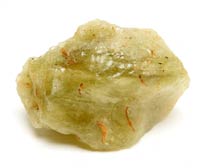 |
Exceptionally Large 764 Gm Piece Of Libyan Desert Glass. One of the most highly-prized jewels in ancient Egypt was the Libyan Desert Glass. Found only between the mega-dunes of the Great Sand Sea in the Western desert of Egypt near the border with the Sudan. This greenish desert glass was used to make Scarabs and other jewels. An amulet in King Tut�s tomb had a scarab as its center featured device. Libyan Desert Glass is actually nearly pure quartz (SiO2) grains that were melted and fused together about 30 million years ago in a huge meteorite impact. Just recently the 19 mile-in-diameter crater made by this meteorite impact was discovered right on the border between Egypt and Libya. It has been named the Kehiaa crater, which means "large." Most pieces of this desert glass are only 20-50 gms in size. Large pieces such as this spectacular 764 gm, 4 �" 3" 3" specimen are usually only seen in museums. As always, the top side is smooth and polished by the wind and the bottom side is rougher and naturally porous. Temperatures over 3,000 degrees F. were necessary to turn sand into this green glass. Only a meteorite impact could create such temperatures. Add $20 for domestic shipping.
Estimated Value $800 - 1,000.
View details and enlarged photo
| Realized
$930 |
Lot 1194 |
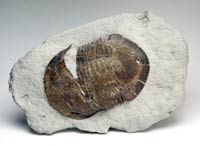 |
Extremely Large, Rare Trilobite From Ohio. Isotelus maximus is the 475 million year old trilobite that has been designated as the state fossil of Ohio. At that time Ohio was situated south of the equator, about where northern Australia is located today. Isotelus maximus was the largest predatory trilobite of its time; a 14½" long specimen was donated to the Smithsonian in 1919 and proudly displayed as the largest complete trilobite known. Larger trilobites have been discovered since then, but most trilobites found are still only 1" to 2" long. This spectacular trilobite is 9½x6" and lies in a 16x10" stone matrix. The head (cephalon) is slightly separated from the rest of the body (thorax) which indicates that this specimen is a molt. Trilobites, like their ancestor spiders, need to shed their hard shell outer layers as they grow larger. Trilobites shed their hard exoskeleton and quickly formed a new larger one. Shed molts (shells) are not rare in the fossil record, but one of this extreme size certainly is. Most trilobite collectors have to be satisfied with a 4" or 5" long Isotelus maximus and wait many years to locate a 9½" giant such as this. Allow $50 for domestic shipping.
Estimated Value $1,100 - 1,300.
View details and enlarged photo
| Realized
$1,495 |
Lot 1195 |
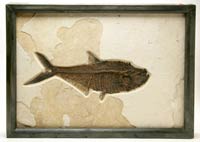 |
Gigantic 19" Long Diplomystus--52 Million Year Old Fish. This enormous 19" x 5 ½" museum-quality fish is from the Green River area of Wyoming and was a very large relative of a herring-like fish that lived in the 50-55 million year old shallow lakes that dried up at that time in Wyoming. At over 19" long, this Diplomystus is just about as big as they are ever found. Virtually complete with an outstanding head with a few teeth visible, complete vertebrae, dark brown skin impressions and most of the delicate fine fins with only minor enhancement of some of the tiniest fins. Some small fish coprolites are present on the large 26" x 23" cream-colored limestone matrix. Professionally mounted and framed for hanging. Add $75 for domestic shipping.
Estimated Value $1,000 - 1,250.
View details and enlarged photo
| Realized
$1,323 |
Lot 1196 |
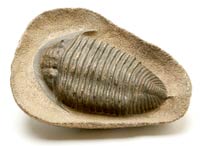 |
Gigantic 375 Million Year Old Rare Trilobite. Rare Homalonotid type trilobite named Brongniartella which measures 9 ½" x 6" and is nicely centered in a 12" x 8 ½" stone matrix. Complete and fully inflated (not compressed) on the matrix. This trilobite had small eyes and a small spine at the end of its tail. The head shield is very detailed with raised eyes and the outlines of the free cheeks that separated to allow the trilobite to molt. Somewhat like spiders, trilobites molted their hard shells in order to grow larger. They accomplished this by splitting the shell on their head and crawling out to allow a larger new shell to solidify. What makes this fossil so special is that the weak areas of the cephalon are outlined so that it is easy to see how the trilobite could craw out of its shell. This rare trilobite is missing from most collections and is extremely impressive. Add $25 for domestic shipping.
Estimated Value $500 - 750.
View details and enlarged photo
| Realized
$540 |
Lot 1197 |
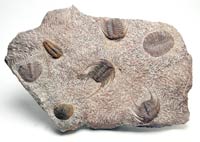 |
Grouping of Trilobites & A Rare Soft-Bodied Arthropod. This large 20x12" stone matrix contains a grouping of three rare spiny trilobites, Selenopeltis bucchi, 4-4½" long. nearly complete with their long spines facing backward. The spines were a defense mechanism to protect them from being swallowed by giant worms and other large predators. This plate also contains a 2½" Pracoparia trilobite plus a partial head shield and tail of two other trilobite, plus a new and poorly-known, soft bodied arthropod known as Duslia insignis. Unlike trilobites they did not have hard shells covering their body and, being soft bodied, are usually so poorly preserved that initially they were thought to be a jellyfish. It is very rare to have such detail as is found on this large 3½x2¾" museum quality specimen. Duslia has an ovoid body with symmetrical body segments and a center ridge running from its hidden head to the tail. Being soft bodied, it is flat on the matrix, unlike the three dimensional trilobites. Duslia is also somewhat similar to a strange pre-Cambrian animal called Dickinsonia from Australia which was thought to have become extinct over 540 million years ago. Duslia and these exceptional trilobites swam in the warm seas of Western Morocco over 475 million years ago. Add $50 for domestic shipping.
Estimated Value $1,300 - 1,500.
View details and enlarged photo
| Unsold |
Lot 1198 |
 |
Hold A Piece Of The Moon In Your Hand. The rarest and most valuable meteorites are the ones that originated from the moon. They are even rarer than martian meteorites bringing prices of more than $5,000 per gram. For some unknown reason, almost all of the known lunar meteorites are very small, weighing 200 grams or much less. This specimen is an Oliving-Phyric Mare Basalt Moon meteorite from the Lunar basin. It has been designated as NWA 3160 and was found in the Sahara desert in 2005 and consists of only one small meteorite weighing just 34 grams or just over one ounce. The .5" x .4" 342 mg. part slice shows mostly basalt with minor sections of Olivine-Gabbro rock from the lunar surface. This mixing of two different rocks attests to the meteorite impact on the moon that enabled these two rock types to be mixed together and ejected from the surface of the moon where they fortunately made their way to earth. Mounted in a special box to allow all sides of the rare meteorite to be viewed (it can be removed) and then placed inside a 4"x 3" Ryker box for protection. Add $20 for domestic shipping.
Estimated Value $800 - 1,000.
View details and enlarged photo
| Unsold |
Lot 1199 |
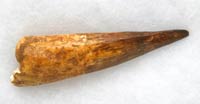 |
Huge 4¾" Spinosaurus Dinosaur Tooth. Made famous in "Jurassic Park II," the enormous theropod dinosaur Spinosaurus, with a huge sail on its back, remains an enigmatic dinosaur since no skeleton even remotely complete has been found. Spinosaurus is mostly known from its teeth, which are fairly common, but rarely are found complete and almost never as large as this 4¾" long beauty, which is a lovely brown color and is complete, with just minor repairs to some cracks in the enamel. The all-important tip is complete and even some root is present at the end. Found in the Kern Valley near Taouz, Morococo (near the border with Algeria), this museum -quality tooth is housed in an 8x6" Ryker mount. Add $15 for shipping.
Estimated Value $400 - 600.
View details and enlarged photo
| Unsold |
Lot 1200 |
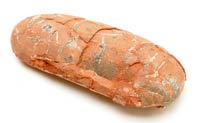 |
Huge, Virtually-Complete Oviraptor Dinosaur Egg. This 8 ½" x 4" Oviraptor egg is much larger than the 7" long eggs normally found in the Nanxiang Basin, Guandong Province of China, as well as more complete, having more than 95% of the original shell intact. Although slightly crushed, the egg maintains its original shape. Its reddish-brown color reflects the color of the stone from which the egg was removed. Oviraptors were strange-looking theropods with a strong beak. They were found to sit on their eggs just like birds do to maintain a constant temperature to assist in their hatching. In 1995 an amazing fossilized Oviraptor was found brooding a clutch of its eggs in Mongolia. The name Oviraptor means "egg stealer" because when they were first discovered in 1920, they were believed to be eating the eggs instead of brooding them. As no more dinosaur eggs are coming out of China, this is an important opportunity to acquire a museum-quality Oviraptor egg. Add $25 for domestic shipping.
Estimated Value $800 - 1,000.
View details and enlarged photo
| Unsold |
Lot 1201 |
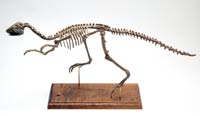 |
Important New Rare Ornithopod Dinosaur - Jeholosaurus. This is the first auction of a mounted new rare ornithopod dinosaur from Liaoning, China: Jeholosaurus shangyuanensis. this exquisite specimen is more complete than the discovery holotype specimen with a much better skull and more than 85% of the total skeleton being real bone. Just the ribs, some neural spines and the end of the tail have been cast from another specimen.
The exact relationship of Jeholosaurus to known groups of dinosaurs has not been determined fully at the present time. It is an Ornithipod and seemingly closely related to taxa referred to as hysilophondontids. One hypsilophodontid named Heterodontosaurus seems to be very close to Jeholoslaurus in both shape and size. There is only a single near-complete specimen known of Heterodontosaurus, whose name refers to the different shape teeth present in the jaw, with the back teeth being somewhat flat like a plant eater and the front premaxillary teeth being sharp and pointed like a meat-eating dinosaur. This probably means that Heteodontosaurus like Jeholosaurus were omnivores eating both plants and insects and possibly small lizards. Being an insectivore is consistent with the body of Jeholosaurus which had fragile, light bones and long legs capable of great speed in running.
Jeholosaurus was found in the 125-130 million year old tuffaceous sandstone of the lower Yixian formation near Sihetun, Liaoning Province, China. An enormous volcanic eruption occurred 130 million years ago burying everything within a 50-60 mile radius. This dinosaur Pompey resulted in the preservation of small delicate dinosaurs, some even with feathers.
This spectacular dinosaur is 25" long, with a superb skull 2½" x 1¾", containing 25 teeth in the upper jaw and 24 teeth in the lower jaw. What is extraordinary about the teeth besides the excellent detail of the scalloped-shaped main teeth and somewhat pointed front teeth is that the white enamel of the teeth has been replaced with translucent brownish-orange Chalcedony. This is highly unusual and gives an excellent contrast with the light brown colored bone of the skull. Most known skulls of Jeholosaurus are only partial and have been crushed and highly distorted. This skull is the exception with only slight distortion in the alighment. The front legs are 5" long, the back legs 11" long. The claws on the front feet are ½" long and up to 1" long on the back feet. The dinosaur has been mounted in a natural walking position that is quite bird-like and it is easy to see that Jeholosaurus could run extremely fast and leap quite high for its size. With its huge feet and long back legs, it womewhat resembles a roadrunner and undoubtedly was also as fast. Much more research needs to be done on this rare dinosaur to determine how it lived and its place in relationship to other hypsilophodonts. This is a rare opportunity to purchase a rare dinosaur missing from most museums outside of China.
Allow $150 for domestic shipping.
Estimated Value $15,000 - 17,500.
View details and enlarged photo
| Unsold |
Lot 1202 |
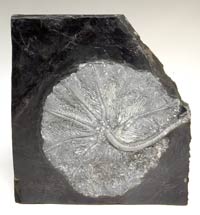 |
Large 200 Million Year Old Crinoid From China. Crinoids are known as "sea lilies" even though they are not plants, but rather animals related to star fish with five-fold symmetry. This 12x11" dark gray slate slab features a superb underneath view of a fully inflated crinoid of the genus Traumatocrinus, which lived in the sea 200 million years ago in Guanling, Guizhou, China. This extremely large specimen is 8½x8½" in diameter and has a 6" long partial stem that was used to anchor it to the sea bottom where it filter-fed on small organisms that would become trapped in the feathery pinnules that connected its outstretched arms. These pinnules are clearly defined with excellent detail of even the small calcite plates that protected them and gave them the freedom to move back and forth in the water. The small trapped organisms were then slowly passed down these pinnules to the mouth, which was located in the center just above the stem. This esthetic light gray crinois is nicely contrasted against the black slate, making for a dramatic, appealing fossil. Add $45 for domestic shipping.
Estimated Value $400 - 600.
View details and enlarged photo
| Realized
$374 |
Lot 1203 |
 |
Large 3.35" T-Rex Tooth. Fossils from a Tyrannosaurus Rex are rare and highly coveted. Of particular interest are large teeth which usually are purchased for inclusion in the few partial skulls that are found. This large 3.35" tooth is a shed, pre-maxillary tooth from the front of the jaw. Pre-maxillary teeth are slenderer and a different shape from the rest of the teeth, as they were used by the T-Rex to strip meat from the bones and not to crush bone. Consequently, they do not break off as often and are much rarer. Shed teeth are teeth that have broken off while a predatory dinosaur was feeding. All recovered T-Rex teeth have some cracks and breaks from being burined for over 65 million years; the cracks on this tooth have been professionally restored, giving the tooth a nice, even, brown color and attractive appearance. It still possesses some sharp serrations and is complete, down to the very tip. This rare find was made in the famous Hell Creek Formation in Harding County, South Dakota and represents a rare opportunity to acquire a sizable, complete T-Rex. Housed in a 5x5" Ryker mount. Add $20 for domestic shipping.
Estimated Value $1,100 - 1,300.
View details and enlarged photo
| Realized
$1,265 |
Lot 1204 |
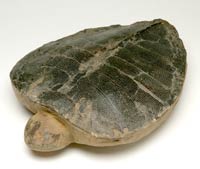 |
Large 40 Million Year Old Chinese Turtle. Large 12x9" specimen of Maomingchelys, an extinct relative of modern turtles that lived more than 40 million years ago in Maoming, Guangdong Province, China. Virtually complete outer shell, dark brown color and heart shaped. The texture of the shell is well detailed as raised dimples. Several bones of the head are also present. The brown fossilized shell still sits atop a hard, lighter brown stone matrix which still may contain some of the limb bones. The sections of the turtle shell become easily disarticulated and it is rare to locate a whole, intact shell such as is present in this specimen. Add $40 for domestic shipping.
Estimated Value $700 - 900.
View details and enlarged photo
| Realized
$805 |
Lot 1205 |
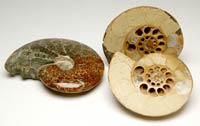 |
Large Ammonite and Nautiloid From Madagascar. Two ammonites from the island of Madagascar. One is a complete polished specimen of Perisphinctes, 6" in diameter, displaying a lovely creamy pattern of strengthening sutures contrasted against the dark brown color of the ammonite.No two species of ammonites have the same suture pattern. The second 5" nautiloid has been cut in two halves and polished to reveal the detail of the inner chambers. Ammonites and nautiloids added chambers as they grew and in this specimen, each chamber is excellently defined and either open or filled with clear quartz or brown pastel colored rock. Add $15 for domestic shipping.
Estimated Value $250 - 350.
View details and enlarged photo
| Unsold |
Lot 1206 |
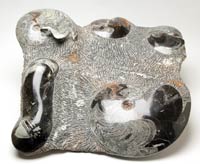 |
Large Ammonite Grouping From Morocco. This large 20x22" stone slab contains four nearly-comlete Goniatites sp. ammonites plus one partial 11" long orthoceras. These polished and detailed ammonites are over 375 million years old from the Atlas Mountains near Tamud, Morocco. The largest goniatite is 12x9" and complete with its curved chambers (like those found in the chambered nautilus), as well as its complete living chamber. The nautilus-like animal lived in the last large chamber of the shell and constantly added new chambers as it grew larger. Most of the closed chambers are a light gray color, with defined walls, and the living chamber is black. There is also a 8½x6" ammonite without its living chamber, as well as two smaller 6½" and 5½" ammonites of the same species. This large grouping would make a beautiful display. Allow $150 for domestic shipping.
Estimated Value $500 - 750.
View details and enlarged photo
| Unsold |
Lot 1207 |
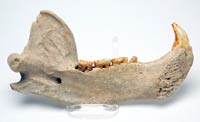 |
Large Cave Bear Jaw With Complete Teeth. This 13" long jaw bone is from a large, adult cave bear, Ursus spelaeus, the largest bear that ever walked the earth. Over 25,000 years old, this complete jaw was found in the Bihor mountains of Romania. The jaw bone is a creamy tan color, nicely contrasted by the cream and orange enamel of the teeth. There are five teeth, with the molars being over 1" long and the fearsome canine tooth being 2" long. The teeth are complete, with just a touch of natural wear on the canine tooth, which occurred when the bear was alive. Add $15 for domestic shipping.
Estimated Value $200 - 300.
View details and enlarged photo
| Realized
$242 |
Lot 1208 |
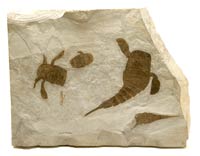 |
Large Plate of Two Euripterids Over 400 Million Years Old. Sea scorpions were fearsome predators in the seas of 400 million years ago, before fish developed teeth and jaws. Known as Euripterids, these aquatic arthropods are distantly related to spiders and scorpions and were the very first sea animals to leave the sea and venture onto dry land. This museum quality grouping of two complete and two partial Euripterids of the species Euripterus remipes is over 410 million years old and was collected from the Bertie group of the Phelps Waterline Member in Herkimer County, New York. In addition to the two partial animals on this 16x12½" dark gray slate slab are two nearly complete specimens, the larger one being over 8" long and the smaller one 4" long. The 8" long Euripterids has its complete swimming paddles, as well as its stinger-like telson and it still appears to be swimming in the water. At over 8" long, it is quite large for this species, which are normally only 4-6" in length. Add $50 for domestic shipping.
Estimated Value $1,800 - 2,200.
View details and enlarged photo
| Unsold |
Lot 1209 |
 |
Nearly Foot Long Mioplosus With 4 Inch Knightia. Mioplosus labracoides was an extinct relative of modern day trout. It is over 50 million years old from the famous Green River Formation near Kemmerer, Wyoming. This 11.5" long fish is large for this species and is virtually complete with excellent detail in the head, body and fins. It is a beautiful chocolate brown color with detailed small fin bones and even some sharp teeth visible in the skull. The 16x13" sandstone matrix plate also has an equally complete 4" long Knightia which was one of the favorite prey fish of the predatory Mioplosus. As an extra bonus, there is a 5" long disarticulated fish on the backside of the slab, as well as a fish still buried in the matrix. Add $40 for domestic shipping.
Estimated Value $500 - 750.
View details and enlarged photo
| Realized
$460 |
Lot 1210 |
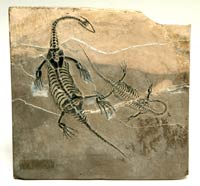 |
Pair Of 240 Million Year Old Mini Guizhou Dragons. Better known as Keichousaurus, these mini dragons have been collected and highly valued for their good luck by the Chinese in the southern province of Guizhou for hundreds of years. These two specimens are nicely centered on an 8½x8½" slate matrix. The larger Keichousaurus is 10" long, which is a fully-grown adult and was buried upside down in its ventral position with an excellent skull and nearly complete except for both front feet and part of one of the back feet, which have been restored. The smaller 7" Keichousaurus is in a typical death position with its neck curved back on its body and a good skull showing its large eyes. Its top (dorsal) side is up and it is complete except for one of its rear feet and the last one inch of its tail, which have been restored. There are two natural calcite lines that run through the matrix and both of the Keichousaurs. This esthetic pair of Keichousaurs were the ancestors of the much larger, long-necked Plesiosaurs such as the Loch Ness monster. Add $25 for domestic shipping.
Estimated Value $600 - 800.
View details and enlarged photo
| Realized
$840 |
Lot 1211 |
 |
Pair of Large 8" Long Trilobites From Morocco. This pair of large 8x5¼" trilobites are of the Andalusiana species and were found near Alnif, in southeast Morocco. They are over 500 million years old with their original calcite shell replaced with iron-rich, orange-brown Limonite. The 16x9" stone concretion was fortunately broken open to reveal these two near-perfect, preserved trilobites. Each half has one positive and one negative trilobite, as one was rightside up and one upside down when they were buried. Usually, trilobites found in concretions such as these have some distortion and damage due to being buried under many tons of rock. Both halves can be carefully placed back together to form the original concretion. Add $45 for domestic shipping.
Estimated Value $300 - 500.
View details and enlarged photo
| Unsold |
Lot 1212 |
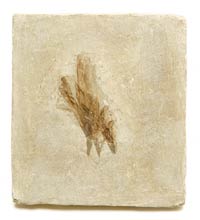 |
Rare and Important Clump Of Three 130 Million Year Old Dinosaur Feathers. These three feathers were found at the site of the discovery of feathered dinosaurs at Liaoning in Northeastern China, a site famous for the remarkable preservation of feathers on some of the small theropod dinosaurs that were quickly buried in volcanic eruptions between 120-130 million years ago. This group of three connected 2" long brown feathers has remarkable detail, showing the delicate veining of the individual barbs. There is no way to determine if these feathers are from a dinosaur or a bird, but the barbs are symmetric, which means that they are definitely not flight feathers and could only have come from a dinosaur or flightless bird, and no flightless birds are known from the Liaoning fossils. Also, the group of feathers match closely a group of comparable feathers found on a complete specimen of Cadipteryx, an emu-sized theropod dinosaur found in the lower 130 million year old Yixian Formation, the same formation as these three feathers. Two photos of the Cauclipteryx and flightless feathers are enclosed. These are the second oldest feathers ever found, exceeded only by the 150 million year old feather of Archaeopterix, the earliest bird from Solnhofen, Germany. Add $15 for domestic shipping.
Estimated Value $900 - 1,100.
View details and enlarged photo
| Realized
$978 |
Lot 1213 |
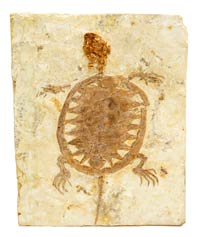 |
Rare Complete 5" Long, 130 Million Year Old Baby Turtle. This museum-quality 5" long baby turtle, Manchurochelys liaoxiensis comes from the very famous fossil beds of Liaoning, China and is perfectly positioned in a 5" x 6" grayish-brown stone matrix. Only a rare event such as the enormous volcanic eruption that took place 130 million years ago in Northeastern China would allow such exquisite detail to be fossilized. Every small delicate bone is preserved articulated which is a very rare occurrence. This little turtle has an excellent skull, complete shell, all legs and tail with detail on even the smallest bones. Manchurochelys was a primitive turtle that could not withdraw its head and legs back into its shell. Preserved in a 5" x 6" Ryker mount. Add $20 for domestic shipping.
Estimated Value $1,000 - 1,250.
View details and enlarged photo
| Realized
$863 |
Lot 1214 |
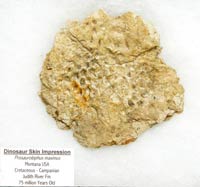 |
Rare Skin Impression Of A Hadrosaur Dinosaur. The rarest of all dinosaur fossils are those of skin impressions because soft tissue is not fossilized except under extraordinary circumstances, such as a dinosaur dying in a river or lake and being quickly partially covered in mud. Such must have been the case for the duckbill dinosaur Prosaurolophus maximus that was the source for this 75 million year old 3" x 2 ½" skin impression fossil in The Judith River Formation of Montana. We can never determine the color of the skin, but the texsture is clearly visible in this fossil with a grouping of small hexagonal depressions found in the rock. The skin would have been bumpy and leathery like that found on an alligator. This important fossil is housed in a 6" x 5" Ryker box for protection. Add $15 for domestic shipping.
Estimated Value $500 - 750.
View details and enlarged photo
| Unsold |
Lot 1215 |
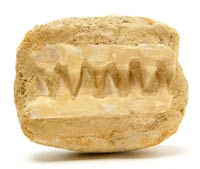 |
Section Of Upper And Lower Jaws From A Mosasaur. Mosasaurs were the top predator of the warm Cretaceous seas 65-85 million years ago. Like the T-Rex on land, Mosasaurs ate whatever they could catch. 6" long sections of both the upper and lower jaws, with 12 teeth up to 1.3" long are nicely presented in the closed position in a 6 ½" x 5" sandstone matrix. The teeth have nearly complete enamel with their sharp tips intact. This showy fossil comes from the Sahara Desert of Morocco. Add $15 for domestic shipping.
Estimated Value $150 - 200.
View details and enlarged photo
| Realized
$156 |
Lot 1216 |
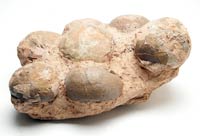 |
Seven Egg Nest Of Chinese Duckbill Dinosaurs. Seventy to ninety million years ago in the Henan Province of China, there were several species of duckbill (hadrosaur) dinosaurs that laid oval eggs. We can't be sure which species of duckbill dinosaur laid these 5½x6" diameter eggs, but because of their oval shape, we can be certain that they were laid by a duckbill dinosaur. All seven of these eggs are uncrushed and their eggshell has been airbrushed to bring out the detail from the stone matrix. These eggs contain between 30% to 80% of their original eggshell with the two best eggs containing at least 80% of their eggshell. The eggshell is a light brown to dark brown in color, which contrasts with the reddish-brown limestone matrix. There has been some repair to the matrix but the eggs are aesthetically positioned, making for an attractive display. All dinosaur eggs are becoming difficult to locate since China has stopped their exportation. Partial nests of eggs are in even greater demand by fossil collectors. Add $100 for domestic shipping.
Estimated Value $1,100 - 1,300.
View details and enlarged photo
| Realized
$1,150 |
Lot 1217 |
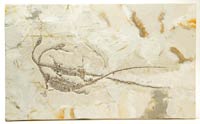 |
Three Chinese Water Dragons On One Matrix. This is an extremely rare museum quality 23x14½" solft tuffaceous sandstone slab containing a family of three nearly complete Sinohydrosaurs (also known as Hyphalosaurus). Sinohydrosaurus translates to Chinese water reptile and they are 130-140 million years old from the Yixian Formation of Liaoning Province, China. Like the more famous feathered dinosaurs, they too were buried in the massive volcanic eruptions that occurred several times in the Liaoning area of Northeastern China. This extraordinary fossil plate contains three nearly complete animals: two adults, 24" and 23½" long, intertwined in the moment they were buried more than 130 million years ago, along with a 4½" baby Sinohydrosaur that was swimming alongside the two parents. These specimens are virtually complete with excellent tiny detail, including the delicate ribs and gastralia, small pointed teeth on the adults and excellent skulls. Some of the legs are disarticulated with some missing bones, but the tails are complete except at the very end of the baby. All of the Sinohydrosaurs are light to dark brown on a cream-colored matrix. Being composed of soft volcanic ash, the stone is very soft and brittle and is nearly impossible to remove without breaking apart. The inevitable cracks in the matrix have been professionally smoothed over with gypsum to give the matrix a neice even appearance. Also, the matrix has been backed to give it more stability. This is a unique opportunity to acquire a family of Sinohydrosaurs that were quickly buried under volcanic ash, thus preserving the social family behavior of Sinohydrosaurs as the adults cared for their young. Add $75 for domestic shipping.
Estimated Value $2,400 - 2,800.
View details and enlarged photo
| Unsold |
Lot 1218 |
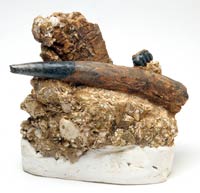 |
Tusk With Teeth From A 20 Million Year Old Aquatic Mammal. Desmostylus Hesperus was a strange looking, extinct acquatic mammal that has been nicknamed a "seahorse." It was the size of a small horse and looked something like a cross between a horse and a hippopotamous. It had a thickset body and stout legs with toes with four hooves. Its most unusual feature was its pair of forward-pointing tusks. These tusks were actually elongated canine teeth that grew to well over one foot in length. This museum-quality specimen consists of a large 10½" complete tusk, as well as a 1¼" tooth and the remains of many clam shells esthetically positioned on a 10x9" base. This 20 million old fossil was found in the Tembler Formation in Fresno County, California and is from a collection formed many years ago. This site has been closed to collecting, resulting in specimens rarely being available for purchase. Add $50 for domestic shipping.
Estimated Value $1,100 - 1,300.
View details and enlarged photo
| Unsold |
Lot 1219 |
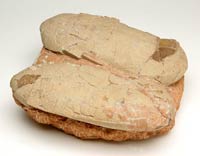 |
Two Oviraptor Dinosaur Eggs From China. Oviraptor dinosaur eggs are in high demand. This pair of museum-quality Oviraptor eggs are 7¾" long by 4" wide and are a light tan color, still sitting on part of the original reddish-brown stone matrix as found in the Nanxiang Basin, Guandong province of China, and are about 70 million years old. Both eggs have more than 90% of their original shell and maintain their distinctive oblong shape with only slight crushing. Most recovered Oviraptor eggs are missing much of their original shell because the shell thickness is thin and easily lost. Both of these eggs have the raised, dimple-like raptor shell pattern in pristine condition. With the supply of dinosaur eggs coming out of China being stopped, it is a rare opportunity to acquire such top quality Oviraptor eggs. Add $50 for domestic shipping.
Estimated Value $1,500 - 1,750.
View details and enlarged photo
| Unsold |
Lot 1220 |
 |
Tyrannosaurus Bataar Egg. A museum-quality complete, inflated egg, 13 ½" x 5 ½", with nearly 100% of the original shell, cracked but intact, with beautiful reddish-brown color on a red, limestone base. The Tyrannosaurus eggs are both the largest and rarest of all dinosaur eggs. They are so rare because Tyrannosaurs did not travel in herds like most other dinosaurs and laid their eggs in isolated nests. This beautiful egg comes from the Henan Province, China. "Tyrannosaurus Bataar is a cousin of Tyrannosaurus Rex from North America; there are no known eggs from a T-Rex. Virtually all of these huge eggs are hatched and flattened and are usually found with only 30-50% of their original shell. Very rare as no more are obtainable from Chine. Add $50 for domestic shipping.
Estimated Value $2,000 - 2,500.
View details and enlarged photo
| Realized
$2,070 |
Lot 1221 |
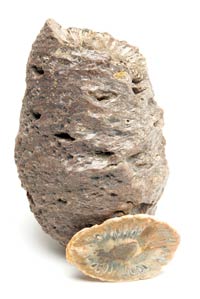 |
Exceptionally Large 5 ½" Long whole Pine Cone From Patagonia. This huge 5 ½" x 3 ½" whole fossilized pine cone is over 210 million years old from Patagonia, Argentina. These detailed pine cones with seeds come from the Arancaria tree (Monkey puzzle tree) which is the most primitive of conifers and was a favorite food of the early sauropod dinosaurs. Most pine cones recovered are only 2-3" long, making this 5 ½" long cone truly exceptional. The pine cone is a dark brown in color with lighter tan seeds visible in its open end. Also, included is a 2 1/2" x 1 ½" polished section of the interior of the pine cone showing detail of the center cone with the surrounding seeds. These pine cones are becoming difficult to locate. Add $15 for domestic shipping.
Estimated Value $350 - 450.
View details and enlarged photo
| Realized
$403 |
|
|